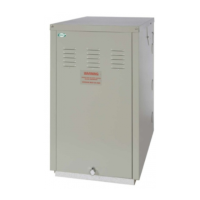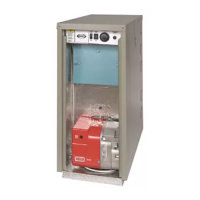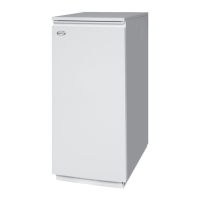5
Grant Vortex Outdoor Module
For short periods - Set the boiler switch to OFF.
To restart, set the switch to ON.
For long periods - Set the boiler switch to OFF. If
required, the fuel supply valve may be closed and the
water and electricity supplies turned off at the mains.
Note: If the electricity, fuel and water supplies are
turned off, the built-in frost thermostat will not
operate.
1 Check that the boiler switch is ON.
2 Check that any remote programmer (if fitted) is
working and is in an 'on' period.
3 Check that all thermostats are set to the desired
setting and are calling for heat.
4 Check if the burner 'Lock-out' reset button is lit. If it
is, press it to start the burner. If the burner fails to light
and goes to 'Lock-out' again, check that you have
sufficient fuel in the storage tank and that the fuel
supply valve is open.
5 Ensure that a fuse has not blown or that the
electricity supply has not failed.
6 Check to see if the safety thermostat has operated
(see section 2.7).
If the burner still fails to light after carrying out these
checks then a fault exists. Switch off the electricity
supply to the boiler and contact your Service engineer.
The Vortex Outdoor modules operate on Class C2
Kerosene only. You should always quote the type of fuel
you require when ordering from your supplier.
Do not wait until the fuel runs out before you order
some more. Sludge in the bottom of the tank may be
drawn into the fuel lines. If it is possible, switch off the
boiler when the new supply is delivered and leave the
fuel to settle for an hour before restarting the boiler.
1 Boiler thermostat - This control allows the
temperature of the water leaving the boiler to heat
the radiators and domestic hot water to be adjusted.
Note: If you have a cylinder thermostat on your hot
water cylinder, this will control the temperature of
your domestic hot water. The boiler thermostat
setting must be equal to or above the cylinder
thermostat setting to enable the cylinder thermostat
to control the domestic hot water system.
The boiler thermostat has an operating range of 65
to 80°C. The following settings are recommended:-
a Heating and hot water in Winter 75°C
b Hot water only in Summer 65°C
2 Burner Lock-out reset button - If there is a
burner malfunction, a built-in safety circuit
switches the burner off and the Lock-out reset
button will light. Usually such malfunctions are
short lived and pressing the reset button will
restore normal operation.
If the burner continually goes to 'Lock-out' a fault
exists or the fuel supply is low. If you have
sufficient fuel, you will need to call your Service
engineer.
3 Safety thermostat - Your boiler is fitted with a
safety overheat thermostat which will automatically
switch off the boiler in the case of a control
malfunction causing overheating.
If your boiler goes off and you try to light it but
nothing happens and the 'Lock-out' reset button on
the burner is not lit, the overheat thermostat has
probably operated. The boiler will not light until
the thermostat is reset. To reset, unscrew the small
plastic cap (see Fig. A), press the button then
replace the cap.
If this condition continually repeats, contact your
Service engineer.
4 Ventilation - Always ensure that the boiler has
adequate ventilation. Any ventilation openings
must not be obstructed. Periodically check that
they are clear.
Do not attempt to 'box in' the boiler or build a
compartment around.
Do not place any combustible material around or
on the boiler or flue pipe.
Do not place anything against the door of the
Outdoor modules that might obstruct the
ventilation openings.
2 - USER INSTRUCTIONS
Turning off your boiler (see Fig. A)
2.4
Points to check if burner fails to light
2.5
About your fuel
2.6
General notes and care of your system
2.7

